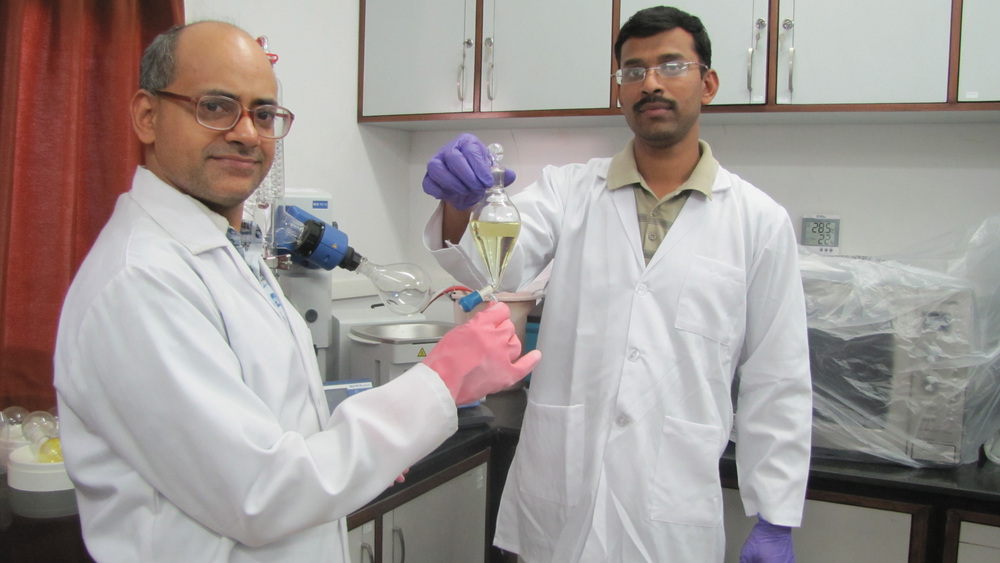New Color Test for Presence of Cosolvent

PHOTO: INDIAN INSTITUTE OF SCIENCE EDUCATION AND RESEARCH
July 17, 2012
BY Ron Kotrba
Scientific discoveries are made accidentally sometimes. Scientists at the Indian Institute of Science Education and Research developed a color test to detect acetone—a potential cosolvent for biodiesel production to reduce heating requirements, agitation/ultrasonication, centrifugation, excess chemicals and washing—and tertiary butyl hydroquinone (vegetable oil antioxidant) levels in biodiesel and vegetable oil, respectively. In a paper on their discovery, IISER researchers discussed how a Japanese group reported (Green Chem., 2011, 13, 1124) on its technique using catfish and jatropha oil feedstock in alkali catalyzed transesterification with methanol in the presence of acetone cosolvent, at 25 degrees Celsius with yields around 95 percent. The researchers—Samrat Ghosh, Shilpa Setia, Sumyra Sidiq and Santanu Kumar Pal—note that for conventional processing to obtain similar yields would require excess methanol (alcohol to oil molar ratio of 6:1) and reaction temperatures of 55 to 60 C, along with vigorous mechanical agitation for at least 30 minutes. One company using such a cosolvent, tetrahydrofuran (THF) according to the IISER researchers, is Canadian biodiesel producer Biox Corp.
While the boiling point of acetone is relatively low—56 C (nearly 133 degrees Fahrenheit)—heating to this degree consumes energy, reducing the net-energy balance of the fuel and increasing production costs. “Instead of heating the biodiesel for an arbitrary period,” write the researchers, “if regular monitoring of the presence of acetone left in the fuel during the heating process is carried out, it will definitely help in optimization of the heating process.” Typically, FTIR or NIR infrared spectroscopy can work on regular intervals, but the researchers contend visual tests would be more convenient, faster and cost-effective for frequent screenings.
If a biodiesel sample with trace amounts of acetone is spiked with a strong base (methoxide/NaOH or KOH) followed by a negligible quantity of p-quinone, it results in an intense green-blue color effect. If a sample has too much catalyst present, addition of p-quinone alone will give the same green-blue effect and therefore can test for presence of both cosolvent and catalyst left in the fuel.
“We observed the p-quinone reaction quite by chance while synthesizing biodiesel at room temperature according to the green technique reported by Maeda et al. in our laboratory from commercially available soybean oil (Fortune brand, India), acetone as cosolvent and sodium methoxide catalyst,” they state, noting the catalyst was prepared by adding sodium metal to anhydrous methanol rather than mixing methanol and NaOH. “The logic behind using Na metal instead of NaOH…was to avoid the byproduct H2O,” and water is obviously undesirable in conventional transesterification. They observed the sample turn blue, then brown-red. To understand this, they performed similar reactions on coconut and mustard oils—but the blue color phenomenon wasn’t observed. “These results made us ponder the connection between the blue color effect and additives in these vegetable oils,” the researchers explain. After investigating, they concluded that the blue color effect was due to the preservative E-319 in the soybean oil. “The preservative is known [as] tertiary butyl hydroquinone (TBHQ) and is a well-known antioxidant in the oil industry,” they state.
Advertisement
Advertisement
The green-blue test can be used to detect the presence of TBHQ-type preservatives in vegetable oils, as well as acetone cosolvent presence in biodiesel. They also note the possibility of TBHQ use as a biodiesel corrosion inhibitor. “Presence of such additives in B100 or blends can be qualitatively detected by our green-blue color test on addition of acetone and a strong base.”
—Ron Kotrba
Advertisement
Advertisement
Upcoming Events





